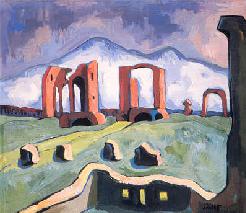Schmidt-Rottluff, Karl |
| PAINTER (GERMANY) |
|
BORN 1 Dec 1884, Rottluf, Sachsen (near Chemnitz) - DIED 10 Aug 1976, Berlin BIRTH NAME Schmidt, Karl GRAVE LOCATION Berlin: Waldfriedhof Dahlem, Hüttenweg 47, Steglitz-Zehlendorf (Feld 013-116 (Abt. 10 E 12) (Ehrengrab)) |
|
Karl Schmidt-Rottluff was the son of a miller. During his schooltime he became friends with Erich Heckel. He studied architecture in Dresden, where Heckel introduced him to Ernst Ludwig Kirchner and Fritz Bleyl. Together they founded the art movement Die Brücke. In 1910 Die Brücke joined the Secession and in 1911 he moved to Berlin. In 1913 Die Brücke was formally abolished. During the First World War he served in Russia and after the war he returned to Berlin. In 1923 he travelled to Italy with Georg Kolbe and Richard Scheibe and in 1930 he lived for a while in Rome. In 1931 he became a member of the Prussian Academy of Art. When the nazis came to power his art was considered 'entartet'. He was forced to leave the academy and was no longer allowed to exhibit. 25 of his works were shown at the Entartete Kunst exhibition in 1937. After the war he returned to Rottluff and Chemnitz and in 1947 he was appointed professor at the Hochschule für Bildende Künste in Berlin. He started painting his famous large watercolours. He was involved in the new Brücke Museum in Berlin that was opened in 1967. Related persons • cooperated with Richter-Berlin, Heinrich |
| Images |
Sources • Baedeker Berlin, Baedeker Verlag, Stuttgart, 1994 • Hammer, Klaus, Historische Friedhöfe & Grabmäler in Berlin, Stattbuch Verlag, Berlin, 1994 |




